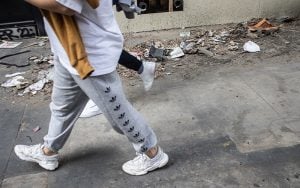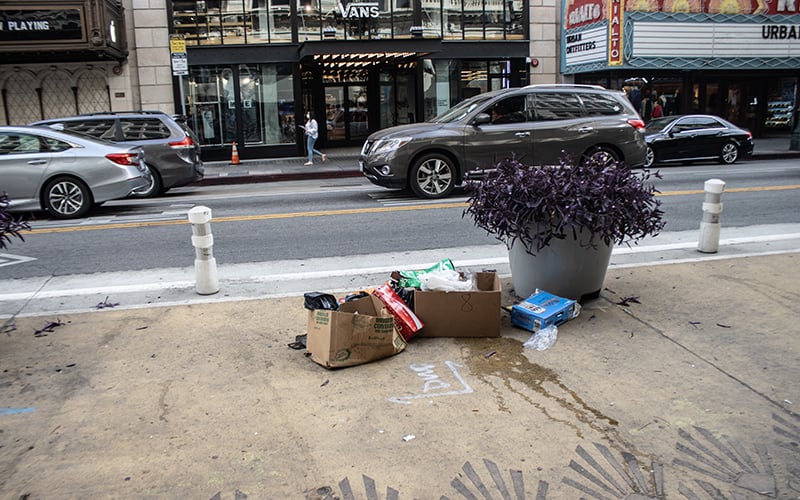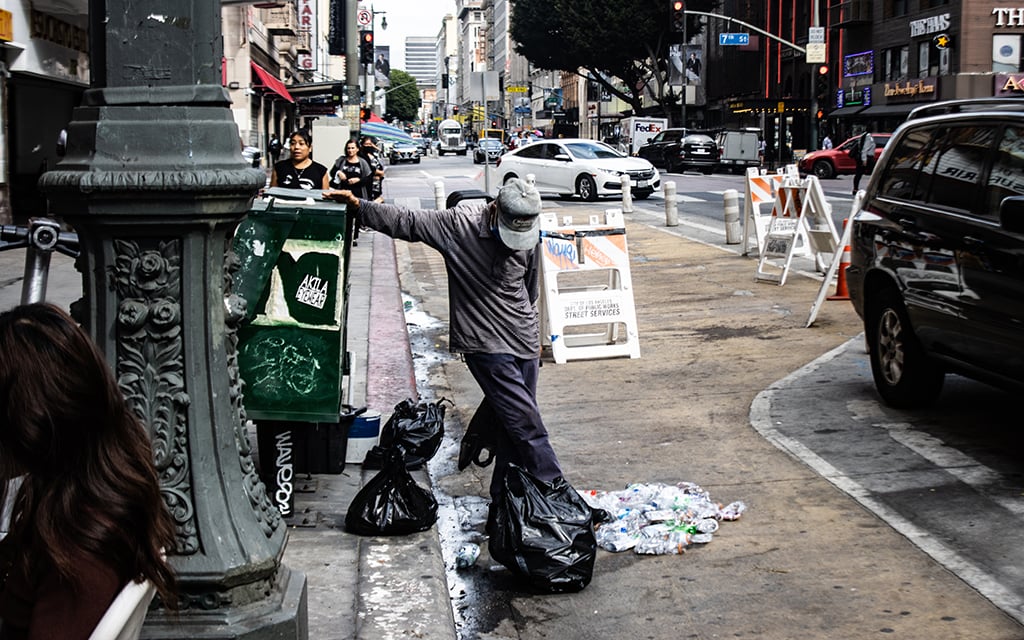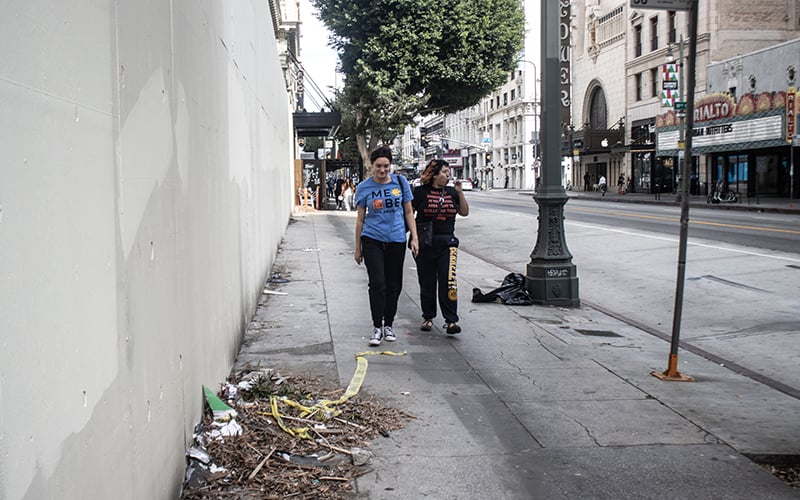LOS ANGELES – This city can feel like it has become a vast dump.
In LA’s glittering downtown – and in nearby, normally picturesque neighborhoods – rotting food piles up on sidewalks, streets and curbs alongside dilapidated furniture, discarded wrappers and abandoned shopping carts.
As people rush past, their noses upturned, disease-bearing rats feast on the refuse, scurrying from alleys as soon as night falls. The ongoing litter problem, worsened in part by the city’s crisis over homelessness, has become part of everyday life here.
“It’s simply people treating the city as their trash can,” said author Charles Fleming, a longtime Angeleno and anti-litter crusader who started the Silver Lake Litter League, one of several such “trash clubs” in LA to deal with the issue.
Among major U.S. cities, Los Angeles was second only to San Francisco when it comes to the percentage of streets in which litter was present, according to a 2022 survey by Construction Coverage, a research and product supplier for the building industry. Phoenix came in ninth.
A 2021 report from Los Angeles City Controller Ron Galperin said illegal trash dumping in the city increased 450% from 2016 to 2020 and up to 600% in some areas.

Trash piles up on a Los Angeles street corner. The city has mountains of trash on sidewalks, streets and gutters. (Photo by Fernanda Galan Martinez/Cronkite News)
“Public spaces meant to be used by everyone are being abused by too many,” Galperin said. “Businesses and individuals are illegally dumping thousands of tons of trash, debris and hazardous waste on our sidewalks and streets, lessening the quality of life nearby.”
Trying to patch the problem, the City Council recently imposed a $100 bounty to those who report illegal dumping, which is just part of the problem.
Some of the trash washes into storm drains, which flow into rivers and out to sea, creating a whole new problem. Bays fill with plastic bags, diapers, Styrofoam containers, drinking straws, masks and all manner of flotsam.
Nets and sophisticated litter catchers have been installed in the city’s rivers as a last-ditch measure in hopes of catching some of it before it can foul beaches and kill marine life.
The mess isn’t exactly what you’d expect to find in a city that prides itself as being a top tourism destination, luring visitors to its beaches, the movie industry and copious sunshine.
And it has developed gradually in a way that more locals take it for granted, putting it lower on the list of priorities than other civic problems like homelessness, crime and most recently, racist talk behind-the-scenes from city leaders.
The trash issue surfaced as an issue in the mayor’s race.
“There is a health crisis also with the waste on the street, the trash on the street, and when the rain starts, by the way, all of that is going in the ocean,” businessman Rick Caruso said at his final debate with his opponent, fellow Democrat Karen Bass, a U.S. representative. “It’s got to get cleaned up. It can’t stay the way it is.”
Caruso promised to hire 500 new sanitation workers to clean the streets and parks if elected. The city needs to prioritize cleaning, he said.
With ballots still being counted, Bass was leading Caruso.
Trash isn’t just about creating an eyesore, but also can lead to severe health issues. These include the potential for groundwater contamination and an increase in rodents or insects that can spread diseases, according to the National Association of Local Boards of Health.

Residents of Los Angeles are used to seeing trash, but they’re fed up and demanding action from the city. (Photo by Emeril Gordon/Cronkite News)
Los Angeles Sanitation & Environment, in charge of keeping the city clean, says it’s doing the best it can dealing with 5,150 street waste containers as well as having to clean up homeless encampments.
The bureau said it responded to 29,828 reports of illegal dumping in 2021 and collected 15,203 tons of solid waste. The average time for the city to respond to an illegal dumping report is five days.
The bureau hired 61 more workers to clean the streets, Mayor Eric Garcetti announced in April. It also assigned 46 workers just to address illegal dumping, part of a $6 million outlay that Garcetti dedicated to deal with the problem.
Making matters worse, illegal dumpers often leave their refuse in homeless encampments – which are another part of the trash problem. The Los Angeles Homeless Service Authority counted 69,144 unsheltered people in 2022 – a 4.1% increase over 2020.
Garcetti said people in the encampments should not be saddled with all the blame.
“Most of the things we saw in the news recently are from illegal dumping, not from homeless folks, so it’s also important not to blame folks that are living on the streets for everything that we see,” Garcetti said, as reported by KCBS-TV.
In addition to clusters of tents and lines of dilapidated recreational vehicles, encampments often are surrounded by assorted bicycles and bike parts, broken chairs, clothing and other castoffs.
If unsheltered people dispose of their trash in proper receptacles, such as those at bus stops, the receptacles quickly fill up and trash spills into the street.
Fed up with the seemingly intractable problem, Fleming and other Angelenos are taking action.
Fleming’s Silver Lake Litter League began with his dog walks in the neighborhood northwest of downtown. On one walk, he tied a plastic grocery bag to his waist, got a 26-inch-long grabber tool from his garage, donned gardening gloves and started picking up garbage.
Fleming, who has written books on Los Angeles, Hollywood and other subjects, sees the city’s rampant trash problem mostly as an outgrowth of habit and laziness.

Los Angeles faces a big problem with trash collecting on the streets – an issue at play in the recent mayoral race. (Photo by Emeril Gordon/Cronkite News)
“The trash in my neighborhood is almost exclusively trash that someone has put on the street because that’s just more convenient for them,” he said. “It’s someone who doesn’t want to go to the dump. It’s someone who doesn’t want to hold on to their trash until they find a trash can. It’s someone who doesn’t want the trash in their car, so they throw it in the gutter.”
Erin Fein, who lives in the Echo Park neighborhood northwest of downtown, two years ago created the Echo Park Trash Club with the help of the apps Instagram and Next Door.
Fein said she saw the need and, in social posts, asked whether neighbors would like to help.
“And it just blew up,” she said. “Hundreds and hundreds of people responded. And it was clear that people were noticing the trash issue was increasing and it really needed some organization around it.”
A typical outing of the Echo Park Trash Club nets about 20 to 40 volunteers and picks up 2 to 4 tons of trash per event.
Fein said the city needs more workers devoted to picking up litter.
“Los Angeles is failing to mitigate and properly manage the issue,” she said. “Because of that, community members are forced to try and work on it themselves.
“But we really do need help. And in an ideal world, the city would be compassionately and effectively working on it in a way that they are not doing right now.”
Despite the city’s best efforts, it’s clear the problem continues to grow – along with the vermin.
“I think people have become oblivious to what’s around them,” Fleming said. “And I think they drive and they throw trash as if they weren’t aware they were having any impact on anyone else.”



